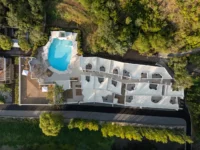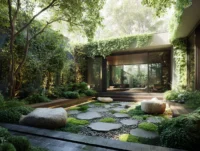The David Rubenstein Treehouse, designed by Studio Gang, represents a transformative step in Harvard University’s architectural evolution. Situated within the new Enterprise Research Campus (ERC) in Allston, the 55,000-square-foot building serves as Harvard’s first university-wide hub for convening, connecting academia, industry, and the broader community. More than a gathering space, the Treehouse symbolizes a new era of sustainability and innovation — as Harvard’s first mass timber building, it sets a precedent for environmentally responsible design across institutional campuses worldwide.
Studio Gang, led by Jeanne Gang, approached the project with a vision of openness, inclusion, and ecological consciousness. As both a Harvard alumna and faculty member, Gang envisioned the Treehouse as a structure that “opens itself up, welcomes all people, and serves as a visual and programmatic anchor” for the ERC. Through this architectural ethos, the Treehouse becomes both a social catalyst and a sustainability benchmark, embodying Harvard’s long-term commitment to environmental leadership.

Architectural Concept and Design Philosophy
Inspired by the natural wonder of climbing into a treehouse, the design evokes a sense of curiosity, exploration, and connection. The building’s central stair, illuminated by overhead skylights, draws visitors upward through the warmth of exposed mass timber — a metaphorical journey through the “trunk” of the structure toward the canopy-like spaces above. This experience of vertical movement celebrates both the human and ecological dimensions of the building, encouraging interaction and reflection at every level.
Three entrances on the ground level lead to a double-height atrium, a dynamic and inviting space that seamlessly integrates interior and exterior circulation. This atrium connects to two covered outdoor porches, extending the building’s social life beyond its walls and offering flexible gathering areas year-round. Each floor supports different modes of engagement, from formal meetings and events to informal collaboration zones designed to nurture creativity and community.

Spatial Organization and Community Connectivity
The Canopy Hall, located on the upper level, forms the heart of the Treehouse. It is a flexible, light-filled space designed for lectures, events, and symposia, complemented by an adjoining open-air terrace with panoramic views of Boston. The structure’s timber columns frame these views while reinforcing the sense of shelter and elevation that defines the building’s “treehouse” identity.
Other floors host a variety of meeting and gathering spaces, supporting Harvard affiliates, visiting scholars, and global industry leaders. Informal lounges and collaborative nooks punctuate the plan, creating natural points of interaction. Every design decision — from the location of entrances to the positioning of windows — reflects Studio Gang’s goal of facilitating connection and movement between people, ideas, and nature.

Mass Timber Construction and Structural Expression
At the core of the project lies its mass timber structure, which not only defines the building’s architectural identity but also drastically reduces its environmental footprint. The canted timber columns on the façade branch outward like the limbs of a tree, supporting cantilevered upper floors while visually emphasizing growth and balance. Each face of the building responds to its context: the north and south façades extend outward to invite approach, while the east and west façades curve inward, creating pedestrian corridors that enhance campus connectivity.
This structural expression underscores Harvard’s commitment to sustainability while celebrating the material’s aesthetic and tactile qualities. The warm tones of wood, visible throughout the interiors, foster a sense of comfort and belonging — an intentional contrast to the often sterile atmosphere of institutional spaces.

Sustainability and Environmental Strategies
Sustainability is not an afterthought but the driving force behind the Treehouse’s design. By using responsibly sourced timber and ground glass pozzolan concrete — a cement alternative made from post-consumer glass — Studio Gang achieved a 55% reduction in embodied carbon compared to a conventional concrete structure. The building operates with zero fossil fuel combustion on-site, relying instead on rooftop solar panels and a connection to Harvard’s District Energy Facility, which provides efficient heating, cooling, and electricity.
The design further optimizes natural daylighting and self-shading, reducing energy demand while enhancing indoor comfort. A raised flooring system conceals mechanical systems, promoting spatial flexibility and efficient conditioning. In line with Harvard’s Healthier Building Academy goals, all interior materials, furniture, and finishes are free from harmful chemical classes such as PFAS, improving both air quality and occupant well-being.
Beyond its interior performance, the surrounding biodiverse landscape supports pollinators and wildlife, creating a living ecosystem that enhances the user experience. Bioswales and rainwater harvesting systems retain and reuse stormwater, demonstrating an integrated approach to sustainability that extends from the building envelope to the site itself.

A Model for the Future of Campus Architecture
The David Rubenstein Treehouse stands as a cornerstone of Harvard’s Enterprise Research Campus, a mixed-use innovation district transforming Allston’s former industrial land into a vibrant hub of research and enterprise. As one of the first completed structures in this new master plan — co-led by Studio Gang and Henning Larsen, with landscape architecture by SCAPE — the Treehouse sets the tone for the entire district.
With its Living Building Challenge Core and Petal Certifications in progress, the Treehouse is more than a functional facility; it is a prototype for the future of university architecture. By merging advanced sustainable technologies with biophilic design and inclusive programming, Studio Gang has created a space that truly embodies Harvard’s mission: to foster knowledge, connection, and innovation for the betterment of society.
In every sense, the David Rubenstein Treehouse is not just a building — it is a living symbol of how architecture can elevate human experience, bridge communities, and redefine sustainability in higher education.
Photography: Jason O Rear
- Adaptive academic design
- biophilic design
- Boston architecture
- carbon neutral buildings
- Collaborative spaces
- David Rubenstein Treehouse
- Educational architecture
- environmental architecture
- Future campus sustainability
- green building strategies
- Harvard Enterprise Research Campus
- Harvard University architecture
- Institutional architecture
- Jeanne Gang design
- Living Building Challenge
- Mass timber building
- Studio Gang architects
- Sustainable campus architecture
- Timber structure innovation
- Zero fossil fuel design


































Leave a comment